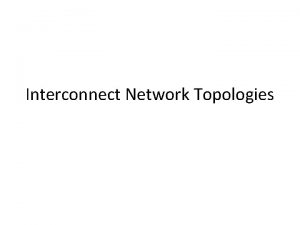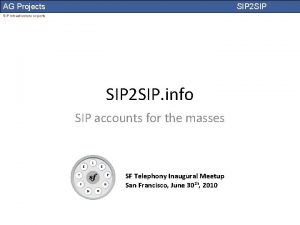Interconnect SIP networks using P 2 P SIP









- Slides: 9

Interconnect SIP networks using P 2 P SIP Marc Bailly marc 1. bailly@francetelecom. com November 2005 IETF 64 1

Interconnection using P 2 P SIP • Use case of P 2 P SIP technology • One way to interconnect (not the only one) • Hierarchical architecture concept November 2005 IETF 64 2

Hierarchical P 2 P • Proposed in section 6. 4. 1 of Singh's and Henning's paper • Why not use some specific principles such as those proposed in paper "Hierarchical P 2 P systems" : – In the top-level overlay network, each "node" is a set of peers. • Require adaptations to Chord (for example) to manage groups instead of nodes • Super peers of each group may fail independently November 2005 IETF 64 3

Interconnection using P 2 P SIP Domain 1. com A D C Domain 2. com B November 2005 IETF 64 4

Example • User A in domain 1. com wants to join a B in domain 2. com: – Local lookup service of domain 1 is used to locate one of the peers of the local domain which belongs to the top level DHT (node C), – Signalization is proxied to one of the gateway node of domain 2. com (node D). This node is located thanks to the top level DHT lookup mechanism, – This node D uses the local lookup service of the callee's network (domain 2. com) to locate the callee. November 2005 IETF 64 5

Top level DHT • Used for inter-domains routing • Two main approaches for routing: – The set of nodes responsible for a domain joins this DHT with a random ID and register their domain on Key. ID = HASH(domain. com) – The set of nodes responsible for a domain joins this DHT with the ID = HASH(domain. com) • We would prefer the second approach: – Takes heterogeneity of domains size into account • Maybe extend this model with several levels in the P 2 P SIP DHT. November 2005 IETF 64 6

Advantages • offers standardized interconnection to isolated islands in a P 2 P way • does not prevent from using optimized P 2 P layer protocol (in a specific environment : mobile or wifi network) • does not prevent from using P 2 P SIP in a domain • does not prevent from connecting centralized networks • enables to have ad-hoc realms (eventually just one UA) November 2005 IETF 64 7

What's next? • Are people interested in this ? • Comments/Discussion ? November 2005 IETF 64 8

References • SIPPEER: A Session Initiation Protocol (SIP)-based Peer -to-Peer Internet Telephony Client Adaptor, Kundan Singh and Henning Schulzrinne • Hierarchical P 2 P Systems, L. Garcés-Erice, E. W. Biersack, P. A. Felber, K. W. Ross and G. Urvoy-Keller • A Dependable Global Location Service using Rendezvous on Hierarchic Distributed Hash Tables, J. Risson, T. Moors and A. Harwood November 2005 IETF 64 9

















